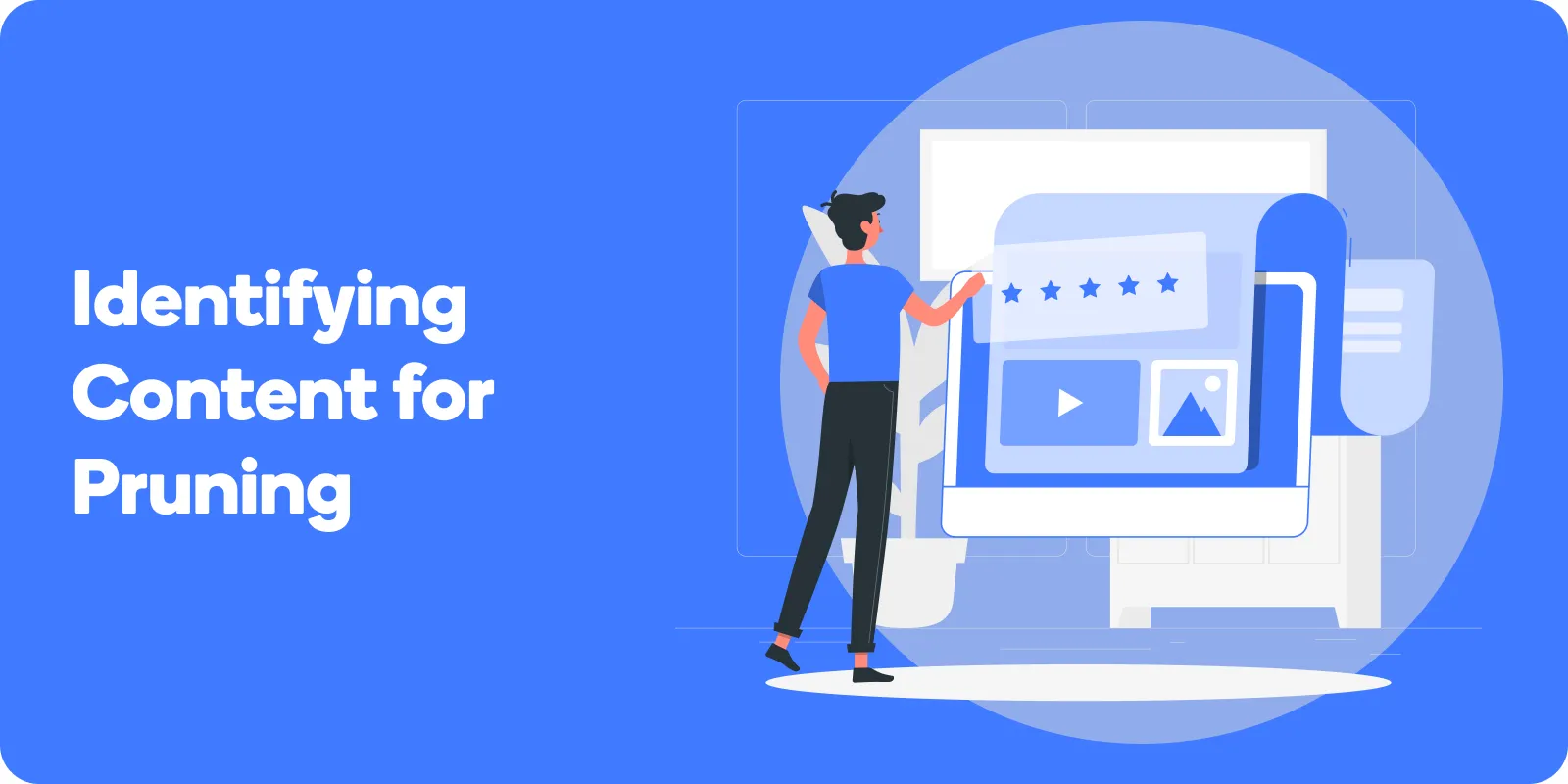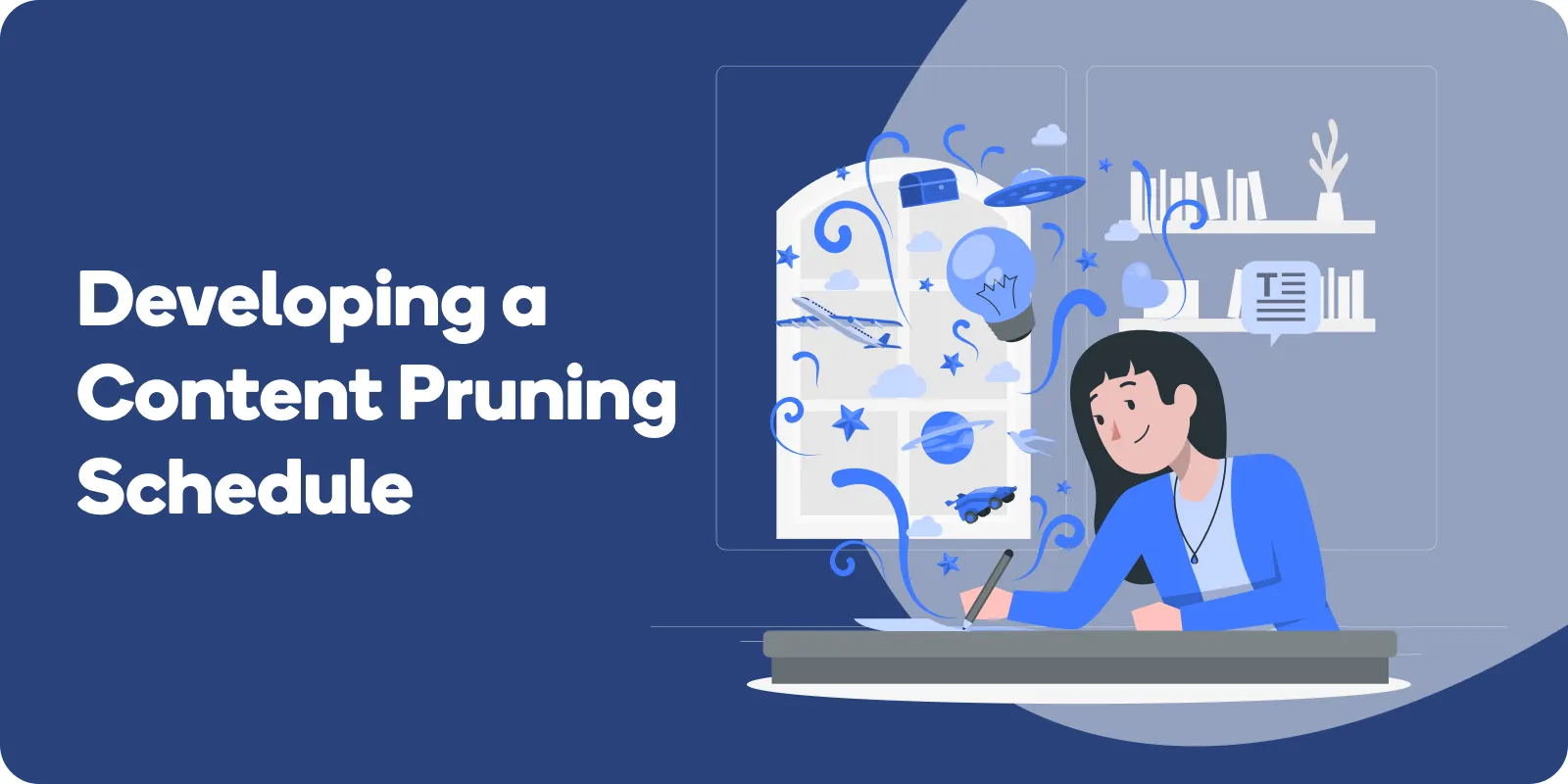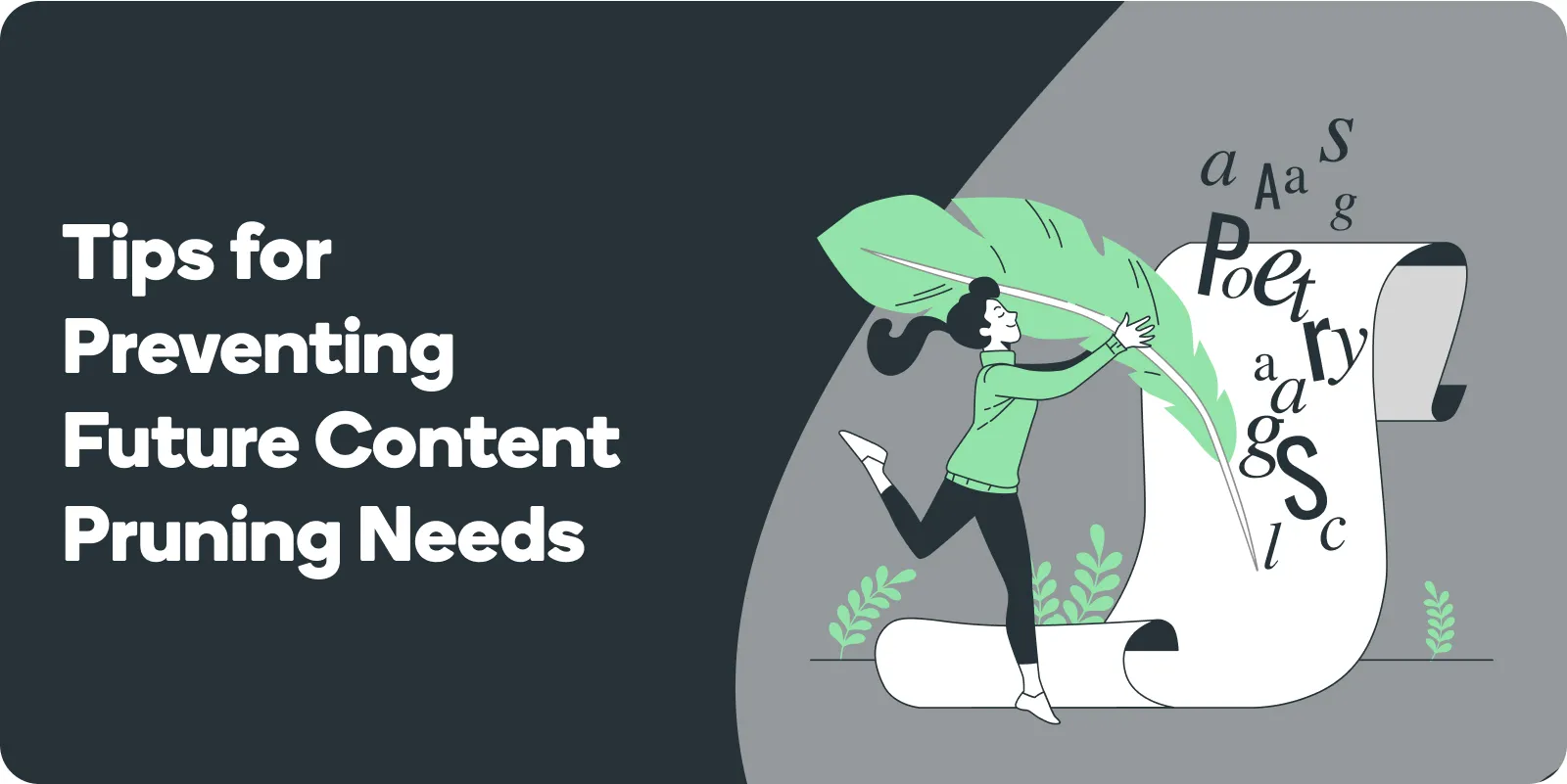In this blog post, you’ll learn how eliminating outdated, irrelevant, or low-value content can boost your search engine rankings, optimize user experience, and facilitate website navigation. So let’s dive in and discover the secrets of effective content pruning.
Understanding Content Pruning
Content pruning may sound like a daunting task, but it’s an essential part of maintaining a high-quality website that ranks well in search engines.
By regularly analyzing your existing content, identifying underperforming pieces, and either updating or removing them, you can enhance your website’s SEO performance and provide a superior user experience.
It’s a powerful strategy that many content marketers overlook, but it can be the key to unlocking your website’s full potential.
So, why is content pruning so important, and how can you implement it effectively?
What is Content Pruning?
Think of your website as a garden, where content pruning is the process of trimming away dead branches, leaves, and flowers to promote growth and vitality.
In the digital world, this translates to eliminating thin or duplicate content and revising out-of-date, low-performing, or duplicate content to enhance website performance and SEO.
By doing so, you free up valuable resources, allowing search engines to focus on indexing and ranking your highest quality content. This, in turn, leads to better visibility, increased organic traffic, and improved user engagement.
So, how do you identify the content that needs pruning, and what tools can you use to make the process more efficient?
The Significance of Content Pruning
Content pruning is like a breath of fresh air for your website. By removing outdated, low-quality, or irrelevant content, you make it easier for search engines to recognize and rank your most valuable and relevant pieces.
This not only boosts your website’s overall quality, but also enhances the user experience by making it easier for visitors to find the information they need.
In turn, this leads to increased engagement, conversions, and brand reputation. So, what are the key benefits of content pruning, and how can you implement it effectively?
The Benefits of Regular Content Pruning
The advantages of incorporating content pruning into your SEO strategy are many. By regularly analyzing your content and making necessary updates or removals, you can enjoy improved SEO performance, enhanced user experience, and streamlined website navigation.
But how exactly does content pruning work, and what are the specific benefits it can bring to your website?
Improved SEO Performance
One of the primary benefits of content pruning is its positive impact on your website’s SEO performance.
When you eliminate low-quality or outdated content, you allow search engines to better understand and prioritize your high-quality, relevant material.
This, in turn, can lead to better search engine rankings and increased organic traffic. By focusing on the content that truly matters to your target audience, you’ll be able to attract more visitors and boost your website’s overall visibility.
Enhanced User Experience
Content pruning doesn’t just benefit search engines, it also significantly improves the user experience on your website.
By removing outdated, low-quality, or irrelevant content, you make it easier for visitors to find the information they’re looking for, leading to increased engagement and conversions.
This, in turn, can help build your brand’s reputation and encourage repeat visits. After all, a satisfied user is more likely to return and recommend your website to others.
Streamlined Website Navigation
Eliminating unnecessary content also has the added benefit of simplifying your website’s navigation.
A clutter-free website is easier for users to navigate, allowing them to quickly locate the information they seek.
This not only improves the user experience, but also reduces the likelihood of visitors leaving your site in frustration.
By regularly pruning your content, you can ensure that your website remains user-friendly and easy to navigate, which is crucial for retaining and attracting new visitors.
Identifying Content for Pruning
Now that you understand the benefits of content pruning, it’s time to learn how to identify which content should be pruned from your website.
It’s essential to approach this process with a clear strategy in mind, as removing the wrong content can be just as detrimental as keeping outdated or low-quality material.
So, how do you determine which content is ripe for pruning? There are a few key factors to consider when evaluating content for pruning.
First, consider the age of the content. If it’s been more than a year since the content was last updated, it may be time to consider prying.
Analyzing Metrics
The first step in identifying content for pruning is to analyze key performance metrics such as traffic, bounce rate, and user engagement on landing pages.
By examining these metrics, you can gain insights into the performance of each piece of content on your website, allowing you to identify underperforming pages that may be hindering your SEO efforts.

Award-Winning
Sales Funnel & Website Expert
Ready for Revenue – Not Just “Traffic”?
- Websites that Work: Clean, fast, built to convert – no design fluff.
- Funnels that Sell for You: Step-by-step paths that turn clicks into paying customers.
- SEO That Hunts Buyers: Show up exactly when prospects reach for their wallets.
Keep in mind that it’s important to look at search results beyond surface-level metrics and consider factors such as search intent and the competitiveness of your target keywords.
Evaluating Relevance and Quality
Once you’ve identified underperforming content, it’s crucial to assess its relevance and quality.
Determine whether the content is still in line with your website’s overall theme and if it provides value to your target audience. If not, it may be time for an update or removal.
Additionally, consider the accuracy, readability, and overall user experience of the content to ensure it meets the standards of your website and audience.
Detecting Duplicate and Thin Content
Duplicate and thin content can be particularly harmful to your website’s SEO performance, as it unnecessarily consumes crawl budget and confuses search engines.
To detect duplicate content, use tools such as WebSite Auditor or Semrush’s tech audit to identify pages with similar titles, meta descriptions, or content.
For thin content, look for pages with a low word count that may be perceived as low quality content by search engines.
By removing or updating duplicate and thin content, you can significantly improve your website’s overall quality and SEO performance.
Effective Content Pruning Techniques
Having identified the content that needs pruning, it’s time to explore effective techniques for carrying out the process.
While the specific approach will vary depending on the nature of the content and your website’s goals, there are several general strategies that can be applied to most situations.
Let’s take a closer look at some of these techniques.
Updating Outdated Information
One of the most straightforward content pruning techniques involves updating outdated information with current data and trends.
This not only ensures your content remains relevant and accurate, but also signals to search engines that your website is well-maintained and up-to-date.
Make it a habit to periodically review your content and update any outdated statistics, broken links, or obsolete information as needed.
Merging Similar Content
Another effective content pruning technique is to consolidate similar content into a single, comprehensive piece.
This not only reduces duplicate content issues, but also helps to create more authoritative and in-depth resources that can rank higher in search engine results.
When merging content, ensure that you properly redirect the old URLs to the new, combined page to avoid any issues with broken internal links or lost SEO value.
Removing Low-Value Content
In some cases, it may be best to simply remove low-value content that doesn’t contribute to your website’s overall quality or SEO performance. This low performing content could include outdated blog posts, duplicate pages, or thin content that offers little value to your target audience.
By eliminating this dead weight, you can streamline your website and make it easier for search engines to find and index your most valuable content.
Monitoring and Evaluating Pruning Results
Once you’ve pruned your content, it’s important to monitor the impact of your efforts on your website’s performance and make adjustments as needed.
This ongoing process will ensure that your website remains optimized for search engines and continues to provide a high-quality user experience.
So, how can you use a web analytics tool to effectively track the results of your content pruning efforts and refine your strategy as needed?
Tracking Key Performance Indicators
To evaluate the success of your content pruning efforts, it’s essential to monitor key performance indicators (KPIs) such as organic traffic, search rankings, and user engagement.
By tracking these metrics over time, you can gain valuable insights into the effectiveness of your pruning content marketing strategy and identify areas for improvement.
If you notice a decline in performance after pruning, it may be necessary to revisit your approach and make adjustments accordingly.
Adjusting Your Pruning Strategy
As with any SEO tactic, it’s important to continuously refine your content pruning strategy based on the results you observe.
This may involve adjusting your pruning frequency, updating your prune content inventory, or exploring new techniques for identifying and removing low-value content.
By staying flexible and responsive to your website’s performance, you can ensure that your content pruning efforts remain effective and contribute to your website’s ongoing success.
Developing a Content Pruning Schedule
Creating a regular content pruning schedule is crucial for maintaining optimal website performance and SEO results.
By consistently reviewing and updating your content, you can ensure that your website remains fresh, relevant, and engaging for both search engines and users alike.
So, how can you develop a content pruning schedule that works for your website?
Determining Pruning Frequency
The frequency of content pruning will largely depend on factors such as the size of your website and the needs of your target audience.
For large websites with a vast content library, more frequent pruning may be necessary to keep things organized and up-to-date.
On the other hand, smaller websites with less content may require less frequent pruning. Ultimately, the key is to strike a balance between maintaining your website’s quality and avoiding excessive pruning that could harm your SEO performance.
Staying Consistent with Pruning Efforts
Consistency is key when it comes to content pruning. By establishing a regular pruning schedule and sticking to it, you can ensure that your website remains current and relevant for both search engines and users.
This may involve quarterly content audits, annual spring cleanings, or ongoing pruning efforts throughout the year. Whatever schedule you choose, be sure to stay diligent in your pruning efforts to keep your website in top shape.
Tips for Preventing Future Content Pruning Needs
While content pruning is an essential part of website maintenance, there are strategies you can implement to minimize the need for future pruning efforts.
By focusing on producing high-quality, relevant content from the start, you can reduce the likelihood of needing extensive pruning down the line.
Here are some tips for preventing future content pruning needs: Make sure your content is well-researched and accurate.
Ensure that your content is up-to-date and relevant to your target audience. Avoid duplicate content and ensure that all content is unique. Use keywords.
Creating a Content Calendar
Developing a content calendar can help you plan and organize your content creation efforts, ensuring that you produce relevant, valuable material that aligns with your website’s goals and target audience.
By outlining your content topics and publishing schedule in advance, you can avoid creating duplicate or irrelevant content that may require pruning later on.
Focusing on Evergreen Content
Prioritizing evergreen content that remains relevant and valuable over time can help reduce the need for future content pruning. By creating content that addresses timeless topics or provides long-lasting value, you can minimize the likelihood of needing to update or remove it in the future.
This not only improves your website’s overall quality, but also helps to maintain its SEO performance.
Regularly Reviewing and Updating Content
Finally, make it a habit to periodically review and update your content to ensure its continued relevance and accuracy.
This can help you catch outdated information or broken links before they become a major issue, reducing the need for extensive pruning efforts.
By staying proactive in your content maintenance, you can keep your website fresh, engaging, and optimized for search engines.
Frequently Asked Questions
How do I prune content in SEO?
Pruning content in SEO refers to the process of removing or improving low-quality or underperforming content from your website to boost its overall SEO performance. Here’s a step-by-step guide on how to do it:
- Audit Your Content: Begin by conducting a content audit. This involves identifying and cataloging all of the content on your website. You can use tools like Google Analytics or a website crawler to help with this process.
- Analyze Performance: Once you have a list of all your content, analyze its performance. Look at metrics such as page views, bounce rate, conversion rate, and time spent on page.
- Identify Underperforming Content: Identify content that is underperforming or not performing at all. This could be pages with low traffic, high bounce rates, low conversion rates, or other negative metrics.
- Decide on an Action: Once you’ve identified underperforming content, decide on an action for each piece of content. You might choose to update it, merge it with another piece of content, redirect it to a more relevant page, or delete it entirely.
- Implement Changes: After deciding on an action, implement the changes. If you’re updating content, this could involve improving the quality of the content, adding new information, or optimizing it for SEO. If you’re deleting or redirecting content, ensure you set up proper 301 redirects so that any existing links to the content are not broken.
- Monitor the Results: After implementing changes, monitor the results. This could involve tracking traffic, rankings, and other key metrics over time to see how the changes are affecting your SEO performance.
What does pruning mean in business?
In business, pruning often refers to the process of cutting back or reducing certain elements that are not contributing to the overall success or growth of the business.
This could involve eliminating underperforming products or services, reducing costs, downsizing staff, or even shutting down branches or divisions of the business that are not profitable. The goal of pruning in business is to streamline operations, improve efficiency, and increase profitability.
What is keyword pruning?
Keyword pruning in the context of SEO refers to the process of removing underperforming or irrelevant keywords from your website or PPC (Pay-Per-Click) campaigns. This can help to improve the efficiency of your SEO or PPC efforts, as it ensures that you’re only targeting keywords that are relevant and have the potential to drive traffic and conversions.
Keyword pruning typically involves analyzing keyword performance, identifying underperforming or irrelevant keywords, and then removing or replacing these keywords.
What is the process of pruning?
Pruning in general terms refers to the process of selectively removing parts of a plant (like branches, buds, or roots) to improve the plant’s health, control its growth, or increase its yield. In a broader context, it can refer to the practice of removing unnecessary or undesirable components from any system to improve its overall performance or efficiency.
The specific steps involved in the pruning process will vary depending on what is being pruned, but the general process often involves the following steps:
- Evaluation: The first step in the pruning process is typically to evaluate the system or object that is being pruned to determine what needs to be removed.
- Identification: This involves identifying the specific components that need to be removed.
- Removal: The identified components are then carefully removed in a way that does not harm the remaining system or object.
- Maintenance: After pruning, the system or object is usually monitored and maintained to ensure its ongoing health or performance.
Whether you’re pruning a tree or an SEO strategy, the goal is the same: to remove unnecessary or underperforming elements in order to improve overall health and performance.
Conclusion
In conclusion, content pruning is a powerful and often overlooked strategy for boosting your website’s SEO performance, improving user experience, and streamlining website navigation.
By regularly analyzing your content, identifying underperforming pieces, and applying effective pruning techniques, you can unlock the full potential of your website and achieve lasting success.
Remember to monitor your pruning results, adjust your strategy as needed, and implement proactive measures to minimize the need for future pruning.
With a consistent and strategic approach to content pruning, you can transform your website into a flourishing garden of valuable, high-quality content.












